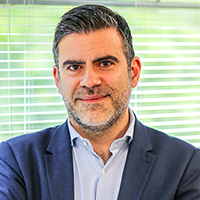In this exclusive interview for WARC’s annual Marketer’s Toolkit release, Steve Challouma – Marketing Director at Bird’s Eye, a leading British food company – speaks to WARC’s Anna Hamill about the continuing power of traditional media, the difference between purpose and CSR, and effective ROI measurement.

Steve Challouma, Marketing Director, Bird’s Eye
WARC: Which consumer trends are having the biggest impact on Birds Eye marketing right now?
Challouma: We’re seeing some very big macro changes in food consumption. In particular, increasing numbers of consumers are opting for less meat and more plant-based or fish-based diets for a variety of reasons including cost, health, and sustainability. Meat-free meals now account for over 30% of all evening meals, and that’s growing year on year. But it’s not a shift to veganism: 90% of the growth in meat-free meals is driven from consumers who eat less meat. What we’re finding is that consumers are just having one or two less meat meals a week. That has implications for our portfolio and how we invest across our range. We’re launching more innovations and ranges into plant-based proteins and vegetables.
The second trend is that consumers are making more conscious choices about their food from a more holistic point of view, from a sustainability and environmental perspective. That could be sustainability of production and sourcing, it could be food miles, plastics and packaging, obesity, or use of palm oil, for example. The concepts of more sustainable food choices that balance nutrition and environmental accountability are becoming the forefront of how we do our marketing.
The third change is how consumers are interacting with media, which is evolving rapidly. Less traditional media TV, more video on demand, people spending more time with their mobiles. That’s having an impact in terms of how we reach consumers, the messages that we communicate with them and the way we allocate our investments for our brands.
WARC: Do you think it’s important for brands such as yours, which is, I guess, a food brand, to take a stand on these types of sustainability issues? And is this different to having a ‘brand purpose’, so to speak?
Challouma: For Birds Eye, we’ve defined a purpose: helping the nation to eat a little more goodness every day. This is a very credible purpose for us and we’ve built it in a very careful and considered way with a big appreciation for our history. We’re a very, very big brand from the penetration point of view: 75% of households buy Birds Eye every year. Eating a little more goodness every day is very credible for Birds Eye because the nature of our portfolio is fundamentally based on healthy categories that consumers in general are not eating enough of: fish and vegetables. The role of brand purpose, in my opinion, is to drive distinctiveness of what your brand is about. And it needs to be credible in relation to what the brand sells and a tool to focus the business on a broader, bigger, long-term goal. What it helps us to do is drive our innovation development, our portfolio decisions, and media investment allocation.
WARC: Do brands sometimes confuse brand purpose and social responsibility?
Challouma: Issue like plastics in packaging, food waste, nutrition in food… they kind of transcend businesses and brands. For me, they are things that companies should be doing in a broad sense irrespective of their brand purpose, because they’re critical not only from a consumer point of view but from an investment point of view. It’s about doing the right thing in terms of the societal/environmental impacts of business, whether the consumer sees it or not – that’s different to the brand purpose in terms of what the brand within the company stands for.
WARC: How do you prioritise media investment at your brand? What trade-offs are you making between quality of reach and quality in terms of context?
Challouma: It partly depends on the brand we’re advertising, but our tendency is we use a reach-based model to our media selection so that we prioritise penetration as a key kind of consumer KPI, and that is a primary driver on how we allocate our investments. In other words, what mix of media channels is going to help us to maximise reach of our advertising? We base it on that and then we overlay insights that we have on short-term return on investment by channel and campaign, and then also the need to ensure a minimum weight behind channels that we’re confident will drive long-term equity and communicate a more emotional message, like television or broadcast video-on-demand.
In terms of media quality, we’re highly data-driven in terms of performance, but it’s very much around evaluating the content relative to the media and what’s fit for purpose. We ensure a degree of experimentation within our model to allow learning around new channels and through partnerships – we’ve had some very successful relationships with partners such as BuzzFeed, with their Proper Tasty food platform. That helps stretch the brand in a more modern way with a distinct audience. We work closely both with our creative and media agencies to ensure our creative’s fit for purpose relative to the channel.
WARC: One of the major things that came out of the Marketer’s Toolkit survey is that many marketing leaders feel as though their brands have gone too far down the path of short-termism and performance marketing. What’s your experience been with that? Is that something that you would agree with?
Challouma: No, not necessarily. We haven’t pushed that far in that direction, fundamentally. We still spend the foundation of our investment on more traditional channels: TV, broadcast video-on-demand, and then supplementing it to extend reach with social. That’s partly driven by our model being reach-driven, rather than highly-targeted programmatic [or]addressable channels, which play less of a role. We’ve also started to experiment with radio again, which we haven’t done for years, and with out-of-home – in particular, digital out-of-home.
We’ve tested with different partners to understand the effectiveness through our brands, but we’re likely to make shifts on an ongoing basis. But to be honest, in our category, the trade-off between the increased media cost and asset creation of more personalisation and more sophisticated ad tech does not pay back yet versus what you lose in reach. We’ve benefited in keeping things quite broad, but that might be because we haven’t cracked it yet.
WARC: Marketers know that they need to be investing more in long-term, brand-building channels. The flip side of that is they feel much more confident investing in performance channels, even if they know it’s a sugar rush, because it’s more immediately measurable. Do you think that some of these traditional channels, the measurability issue is perhaps a block for people wanting to invest more?
Challouma: It doesn’t surprise me that much. The issue that you described isn’t as acute [for Bird’s Eye]because we are able to measure the relative performance quite clearly in terms of what TV delivers for us in the short-term. The key challenge that potentially creates barriers to investing more in TV for us is the loss in reach, quite frankly, and the associated inflation that comes with that. The increased cost – and therefore pressure – that puts on return on investment is becoming a bigger issue.
The broader issue that’s a bit unsatisfying at the moment is the ability to measure reach properly across these channels. We have to use hypothesis and conjecture or modelling tools, but it’s not necessarily based on reliable sources. It doesn’t take away the return on investment modelling that we do, but the two bigger factors will be the inflation that we see on those channels and the inability to measure duplicated reach.
WARC: We’ve touched on some of these themes already around the concept of building your brand over the long term with driving short-term performance. What are some of the challenges that you’ve had in that and what are some of the lessons that you’ve learned?
Challouma: We’re heavy advocates of ensuring we balance short and long-term brand building. I don’t feel a lot of pressure in my business to push towards short-term performance media.
We take a very broad role of how to build our brand: the holistic impact of the collective consumer experience through the shopper journey, the in-home journey, etc. In the long-term, that makes an accumulated difference to brand building, of which media and comms is just one bit. Innovation plays an important role as does renovation, distribution, shelf position, pack design, and product quality. All of these things have an accumulated impact on both short-term performance and long-term brand building…. it’s an important point because I think people emphasise the media part. We think it’s critical to look at things like your pack design. You can have the best media campaign in the world, but if your execution at shelf is shoddy, it’s a waste of money.
We measure the unprompted online chatter around our brands and products with social listening, but the main in terms of [measuring]return is econometrics. That gives us a very, very direct short- and long-term measurement in terms of the impact of our investments by campaign, by channel, and relative to other elements of the marketing mix whether it’s price, promotions or distribution. That’s really critical and it’s very useful because it gives marketing in our business financial credibility.
The other thing that we’re very careful to look at is we measuring the impact of not investing in brand, because what we find is investing in brands isn’t always about growth. It can also be about sustaining the consumer base that you have and stemming a leaky bucket that occurs if you don’t invest in media.
WARC: What kind of data are you using to uncover those insights? How is it informing the decisions you’re making?
Challouma: On an ongoing basis, from the media point of view, we will measure the fundamentals – reach, impressions, views, that kind of stuff – just to be able to measure how many consumers we’ve reached. We have our own measures of brand connection, brand equity that we measure, which look at unprompted ongoing chatter around our brands – both positive and negative – from product reviews on social media.
There are some more conventional brand health metrics around awareness to consideration, that are more aligned to traditional marketing funnel metrics. Clearly also, we measure consumer KPIs around penetration, market share, frequency of purchase, and we leverage retailer data.
We use all that stuff to supplement, but the principal [approach]is econometrics, I would say. On an annual basis we do a very deep dive, but then quarterly tracking that allows us to improve the short and long-term return on an ongoing basis.
–
This article first appeared in www.warc.com
Seeking to build and grow your brand using the force of consumer insight, strategic foresight, creative disruption and technology prowess? Talk to us at +9714 3867728 or mail: info@groupisd.com or visit www.groupisd.com




